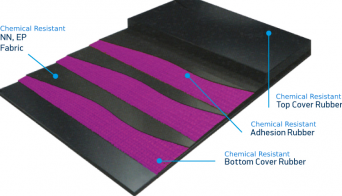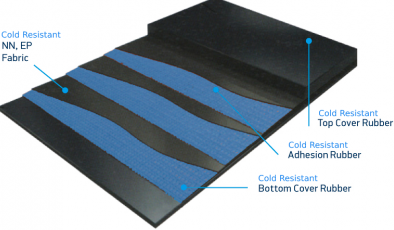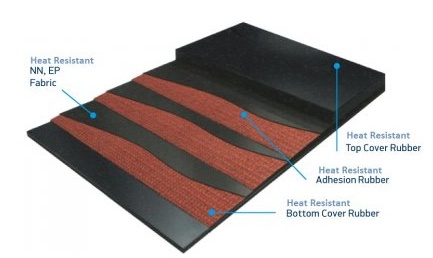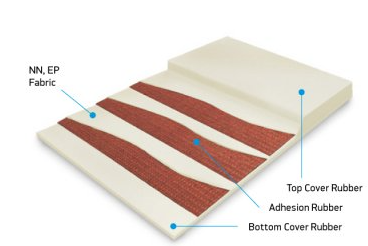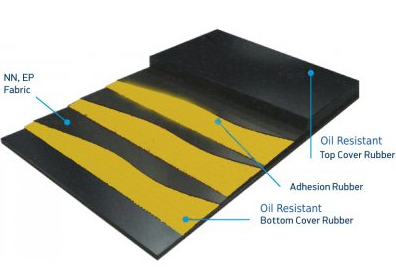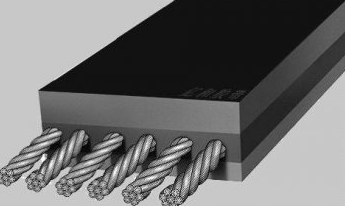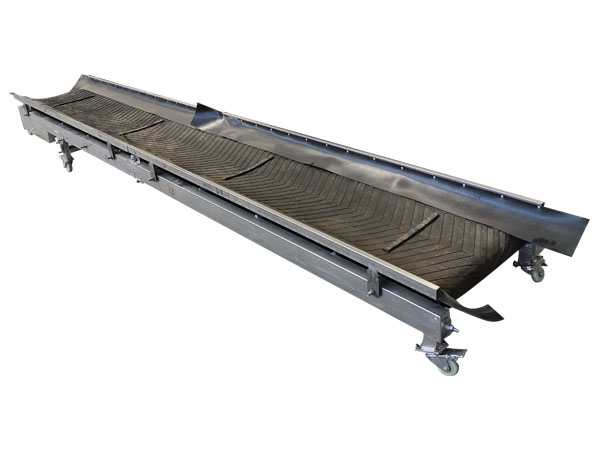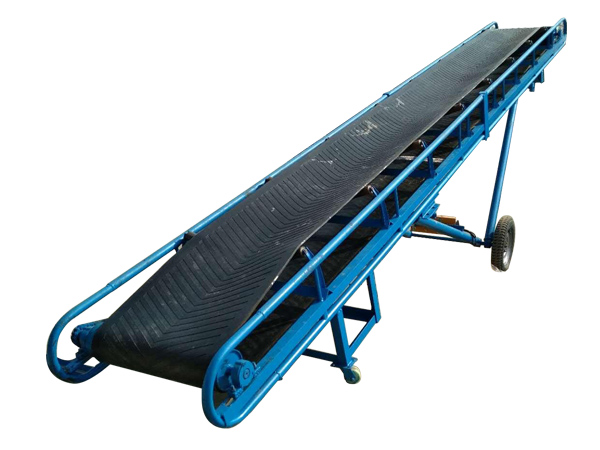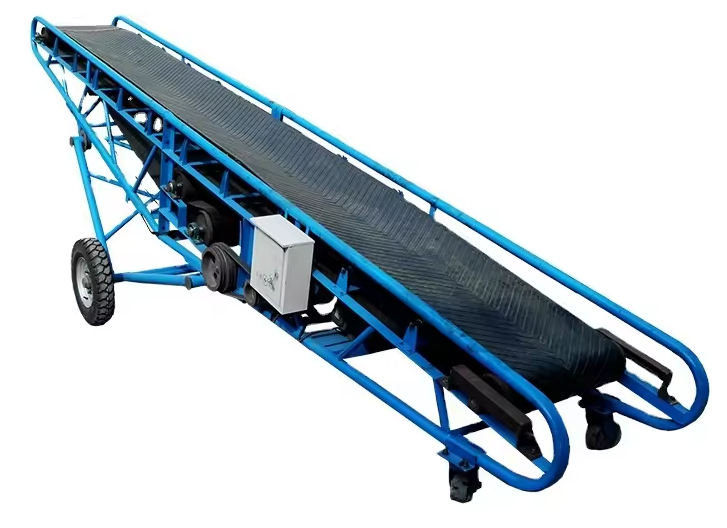
Rubber conveyor belt
Rubber conveyor belt is a continuous conveying equipment with multi-layer rubber and fiber as the core structure. It is suitable for horizontal or inclined conveying of block, granular and powdery materials. The price generally ranges from $7 to $20 per meter and can be customized.
Belt width: 400/500/650/600/800/1000/1200/1500mm
Conveying length: 10-30 meters
Conveying capacity: 30-3000t/h
Conveying speed: 1.25-2.0m/s
Promise: Free shipping/5-day delivery/30-day return and exchange/customization support
What is a rubber conveyor belt?
Rubber conveyor belt is a continuously moving belt made primarily of rubber or rubber-like material used to transport goods, materials or items from one place to another in a variety of industries. These belts are widely used due to their durability, flexibility and ability to withstand a wide range of loads and environmental conditions. They are usually constructed of a multi-layer structure, including a rubber outer layer for protection and a fabric or steel cord core for strength and stability.
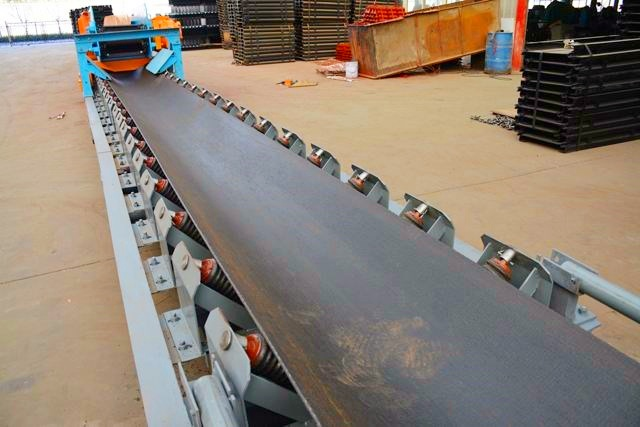
The rubber belt has a smooth surface and moderate friction, which can ensure the smooth movement of materials during transportation, reduce spillage and loss, and is especially suitable for conveying materials in various forms such as granular, blocky and powdery. At the same time, it can realize horizontal, inclined and even vertical transportation, and can flexibly adapt to different sites and process requirements, easily cross obstacles and change the direction of transportation.
Video of rubber conveyor belts
What are the classifications of rubber belt conveyors?
Rubber conveyor belts can be categorized into horizontal, inclined, and Z-type conveyor belts based on their application scenarios and structural characteristics. These three types of conveyors are primarily used for transporting materials across flat surfaces or at different heights. Their operating principles, scope of application, and design differences constitute the primary classification of rubber conveyor belt systems. The following is a detailed introduction to these three types:
Horizontal rubber belt conveyors:
Features: Used for horizontal or nearly horizontal (≤10°) material transportation, suitable for long-distance transportation of bulk or piece goods.
Application: Suitable for production lines and assembly lines within factories, as well as scenes where various items need to be transported smoothly and continuously, such as packages, electronic products, food, etc.
Inclined rubber belt conveyors:
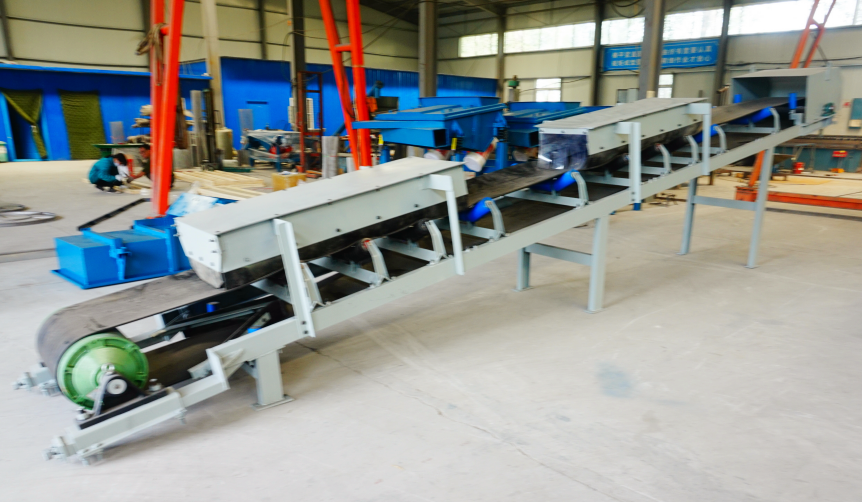
Features: The inclination angle is usually 10°~25° (special designs can reach 30°), suitable for climbing conveying, and anti-slip belt surfaces (such as patterned belts, sidewalls or diaphragms) are required to prevent materials from slipping.
Application: Widely used in occasions where materials need to be lifted to different heights or for vertical material transfer during production. The selection of the inclination angle needs to take into account the characteristics of the material to prevent the material from falling back or slipping.
Z-type rubber belt conveyor
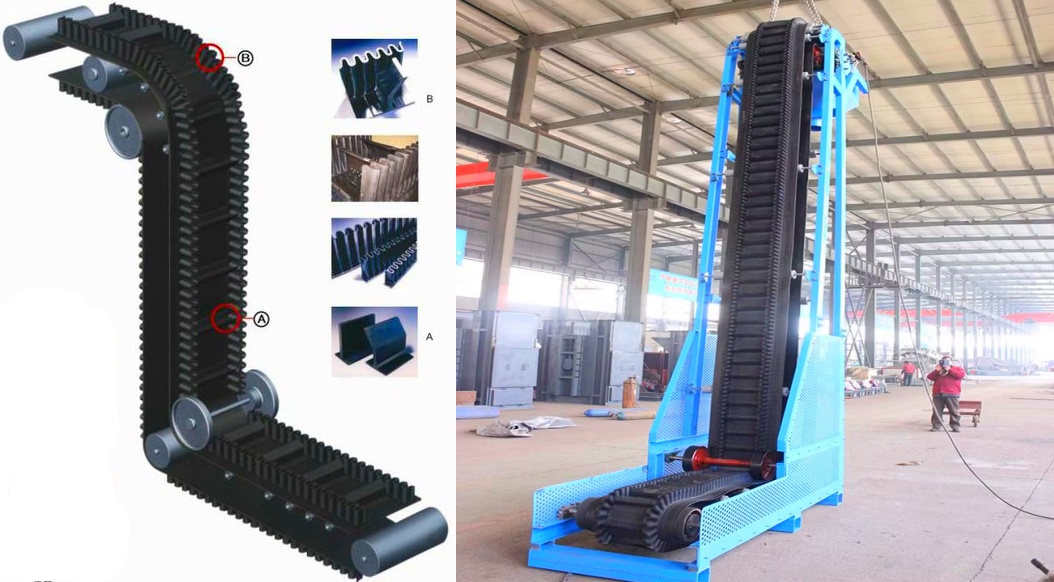
Features: Rubber belt conveyor combines the characteristics of horizontal and inclined conveying to form a "Z"-shaped layout (with an inclination of up to 90°), which can effectively lift materials from a lower horizontal plane to a higher horizontal plane and connect them through the inclined section in the middle.
Application: It is suitable for occasions where a large height lifting is required but a long inclined conveyor cannot be used due to site restrictions. It can realize the vertical lifting of materials and the connection of horizontal conveying, and is often used for loading and unloading materials or transferring materials between different floors.
What are the different types of rubber conveyor belts?
Rubber conveyor belts can be classified into single-layer fabric rubber conveyor belts and multi-layer fabric rubber conveyor belts according to the material of the conveyor belt. According to different application scenarios, multi-layer fabric rubber conveyor belts can be divided into heat-resistant, high-temperature resistant, wear-resistant, fire-resistant fabrics, food safety textile rubber conveyor belts, etc.
Single-ply textile rubber conveyor belts
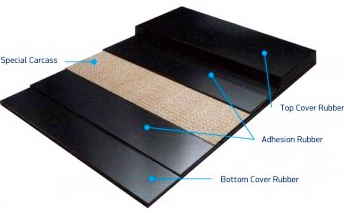
Construction: Excellent resistance to bending fatigue, impact and shock resistance, and excellent grooving properties.
Features: Single-ply carcass provides tension in excess of 2000kN/m. Low elongation allows for short take-up strokes.
Purpose: Single-ply textile rubber conveyor belts are developed to withstand the most demanding conditions and heavy industrial use, conveying large amounts of material.
Multi-layer textile rubber conveyor belt
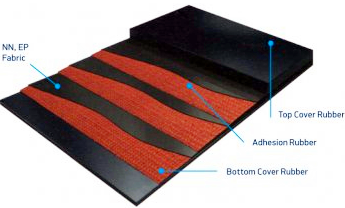
Structure: Multi-layer textile rubber conveyor belt consists of cloth cover layer, carcass cover layer and degreased cloth
Features: It adopts a unique rubber mixture, which has the advantages of wear resistance, high temperature resistance, cold resistance, acid resistance and fuel resistance.
Applicable scenarios: Suitable for high tensile strength and long-distance transportation.
|
Type |
Picture |
Features |
Applicable scenarios |
|
Chemical corrosion resistant textile rubber conveyor belt |
|
Rubber design, and can withstand a variety of chemicals |
Conveying acidic and alkaline materials in chemical plants, fertilizer plants, pulp and paper mills and other industrial and mining enterprises |
|
Cold resistant textile rubber conveyor belt |
|
Low temperature resistant rubber layer |
Outdoor transportation of materials in cold areas, used to transport materials to cold storage |
|
Fire resistant textile rubber conveyor belt |
|
Fireproof performance |
Thermal power stations, mining, coal cleaning and other industries |
|
Food safety textile rubber conveyor belt |
|
Anti-tear and impact protection |
Food transportation and transportation of heavy materials |
|
Oil resistant textile rubber conveyor belt |
|
Made of synthetic oil resistant rubber, which can reduce wear |
Parts coated with machine oil, heavy coal handling carbon in coking plants and power stations |
|
Wire rope rubber conveyor belt |
|
Bending fatigue resistance |
Long-distance, high-load, high-resistance cargo transportation |
Technical parameters of rubber conveyor belt
|
width |
Conveying length(m) power(kw) |
transfer speed (m/s) |
Delivery volume (t/h) |
||
|
400mm |
≤10 |
12-15 |
15-30 |
1.25-2.0 |
30-60 |
|
500mm |
≤10 |
12-15 |
15-30 |
1.25-2.0 |
40-80 |
|
650mm |
≤10 |
12-15 |
15-30 |
1.25-2.0 |
80-120 |
|
800mm |
≤10 |
12-15 |
15-30 |
1.25-2.0 |
120-200 |
|
1000mm |
≤10 |
10-20 |
20-40 |
1.25-2.0 |
200-320 |
|
1200mm |
≤10 7.5 |
10-20 7.5-15 |
20-40 15-30 |
1.25-2.0 |
290-480 |
|
1400mm |
≤10 11 |
10-20 15-22 |
20-40 22-45 |
1.25-2.0 |
400-680 |
|
1600mm |
≤10 15 |
10-20 22-30 |
20-50 30-75 |
1.25-2.0 |
600-1080 |
|
1800mm |
≤10 18.5 |
10-20 30-45 |
20-50 45-110 |
1.0-2.0 |
800-1500 |
|
2000mm |
≤10 22 |
10-20 45-55 |
20-50 55-132 |
1.0-2.0 |
1000-2000 |
|
2400mm |
≤10 |
10-20 |
20-50 |
1.0-2.0 |
1500-3000 |
The difference between rubber conveyor belt and other conveyor belts
|
Comparison items |
Rubber conveyor belt |
PVC/PU conveyor belt |
Metal conveyor belt |
|
Temperature resistance |
-10℃~200℃ (heat-resistant type) |
-10℃~80℃ |
≤800℃ (stainless steel) |
|
Wear resistance |
Excellent (covering rubber can be replaced) |
Medium |
Excellent |
|
Cost |
Medium |
Low |
High |
|
Applicable scenarios |
Heavy load, complex environment (mines, ports) |
Light load, food/electronics industry |
High temperature, corrosive environment |
How does the rubber conveyor belt work?
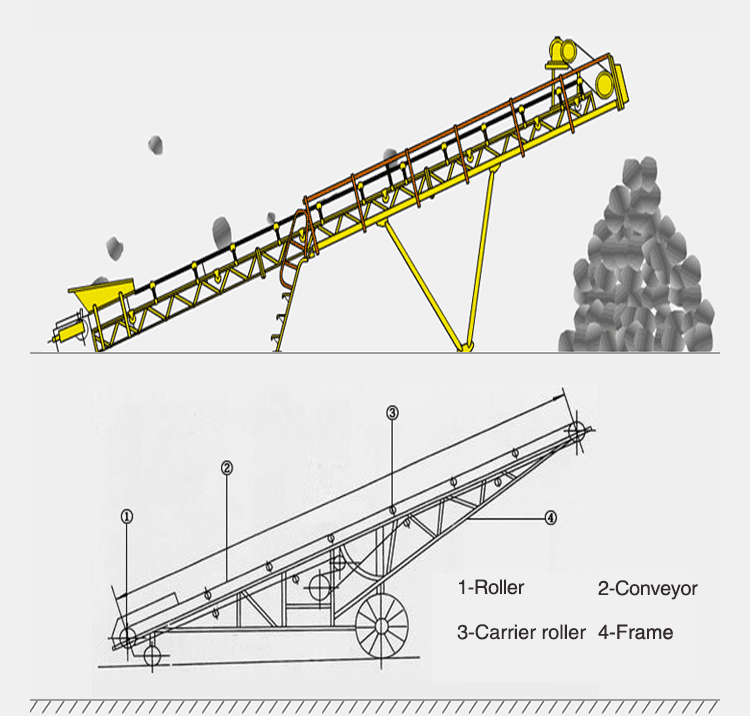
Loading: The material is placed on the belt at the loading point, and the flow is usually controlled by a hopper or chute.
Transport: The rubber conveyor belt transports the material along its path during movement.
Discharging: At the discharge end, the material is released by gravity (when the rubber conveyor belt bends around the tail pulley) or other equipment.
What is the structure of Rubber conveyor belt?
Rubber conveyor belts are usually composed of the following layers: covering rubber (surface layer), skeleton material (reinforcement layer), bonding layer and edge protection
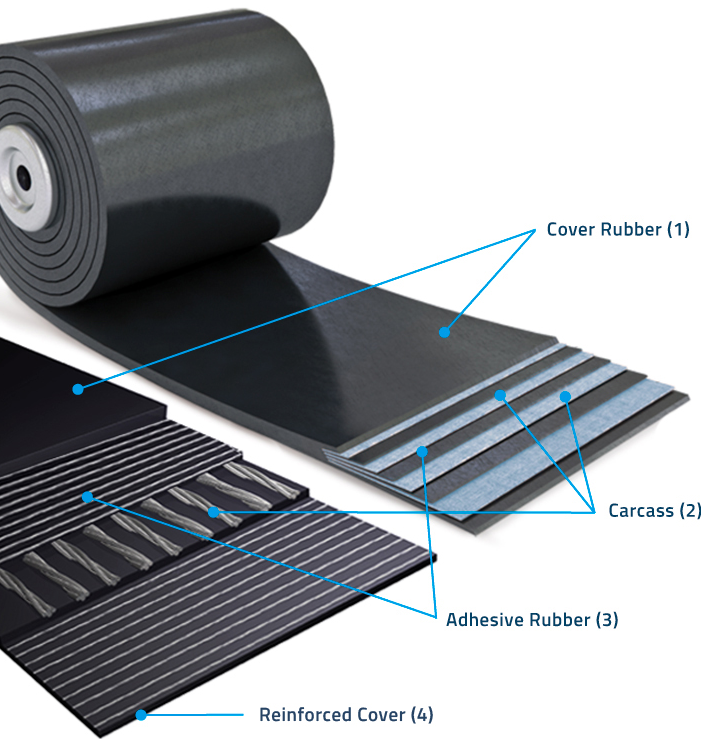
Covering rubber: It must have the characteristics of wear resistance, impact resistance, corrosion resistance, etc., and is divided into upper covering rubber (thicker) and lower covering rubber (thinner).
Skeleton material: including canvas layer (commonly used polyester, nylon, cotton fiber, etc., to provide tensile strength) and wire rope core (such as long-distance, large-volume transportation).
Adhesive layer: ensures the close bonding of rubber and skeleton material.
Edge protection: Some conveyor belts are designed with tear-resistant edges or sidewall structures.
Rubber Conveyor Belt Accessories
As a complete conveying system, a rubber conveyor belt requires not only the conveyor belt itself but also many key components to work together to ensure stable operation. These components include support and drive components, protective and auxiliary components, and safety and control components.
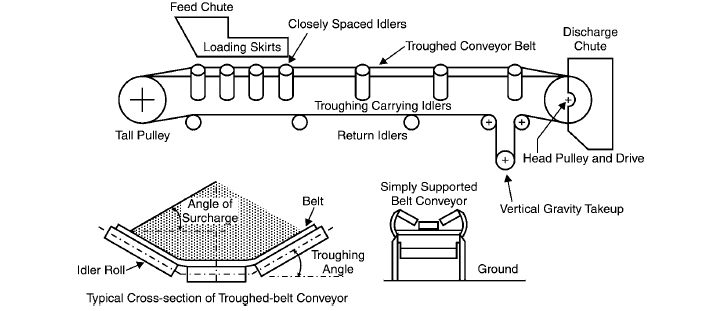
Idler rollers: These are common components in conveyor belt systems, acting like the "wheels" of the conveyor belt. Rollers are installed on the conveyor frame to support the conveyor belt and the material on it. Depending on their function, they are classified as load rollers (supporting the conveyor belt and material above) and return rollers (supporting the empty conveyor belt below). Their quality and arrangement directly impact the smoothness and service life of the conveyor belt.
Rollers: The rollers are the core components that drive the conveyor belt.
Drive rollers: Driven by an electric motor, they are the power source of the entire system, driving the conveyor belt forward through friction.
Bend rollers: They change the direction of the conveyor belt, for example, at the end of the conveyor belt, allowing it to form a closed loop.
Tensioners: Conveyor belts stretch and deform during operation. The tensioner's function is to adjust the belt tension to maintain the proper tension and prevent slipping and deviation. Common tensioning methods include spiral tensioning and weight tensioning.
Cleaners: Mainly installed at the discharge end of the conveyor belt, they remove residual material from the belt surface. This prevents material from sticking to the conveyor belt and causing contamination or damage, and protects the rollers and idlers from wear. Chutes and Skirts: At the conveyor belt's loading point, the chutes guide the material smoothly onto the conveyor belt, while skirts are installed on both sides of the chutes to prevent material from spilling during loading.
Frame: The "skeleton" of the entire conveyor belt system, supporting all components, including rollers and drums, and ensuring the overall structural stability of the system.
What are the characteristics of rubber conveyor belts?
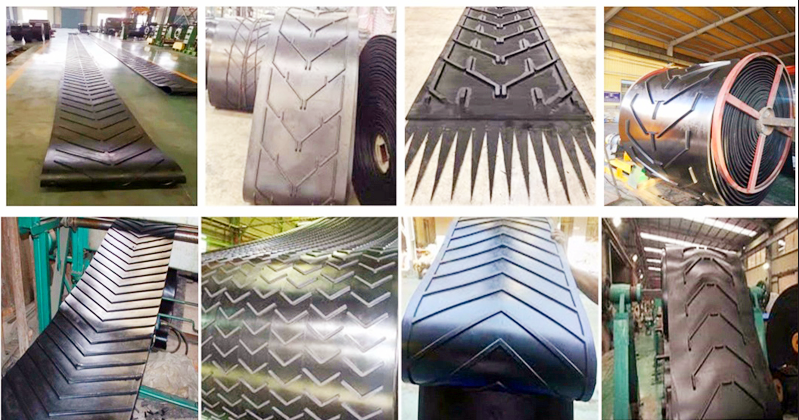
Rubber conveyor belts are widely used in material transportation due to their excellent performance. Their core advantages lie in their high strength, heat resistance, corrosion resistance, and flame retardancy. These features enable them to not only meet the demands of long-distance and high-volume transportation, but also operate safely in a variety of complex working conditions, including extreme temperatures, corrosive environments, and flammable and explosive locations. Furthermore, rubber conveyor belts support wide-angle and enclosed conveying, effectively eliminating the problem of material spillage.
Rubber conveyor belts use high-strength skeleton materials, high tensile strength, good wear resistance, and are suitable for long-distance and large-volume transportation.
Conveyor belts can withstand high temperatures above 300°C, and can also be used in low-temperature environments of -50°C. The transportation of corrosive materials such as chemicals and fertilizers is also common.
Conveyor belts are flame retardant and safe, and meet the safety standards of flammable and explosive places such as coal mines and tunnels. They are self-extinguishing and reduce the risk of fire.
Rubber conveyor belts can achieve closed conveying, prevent material spillage and environmental pollution, and are suitable for large-angle conveying.
What are the applications of rubber conveyor belts?
Rubber conveyor belts are very common in industries such as mining, manufacturing, agriculture and logistics. They can be customized for specific applications, such as heat resistance for high-temperature materials, oil resistance for greasy environments, and wear resistance for rough and heavy loads. Conveyor belts operate through pulleys and rollers in a conveying system driven by a motor, and are highly regarded for their efficient transportation of bulk materials such as coal, ore, grain or packaged goods.
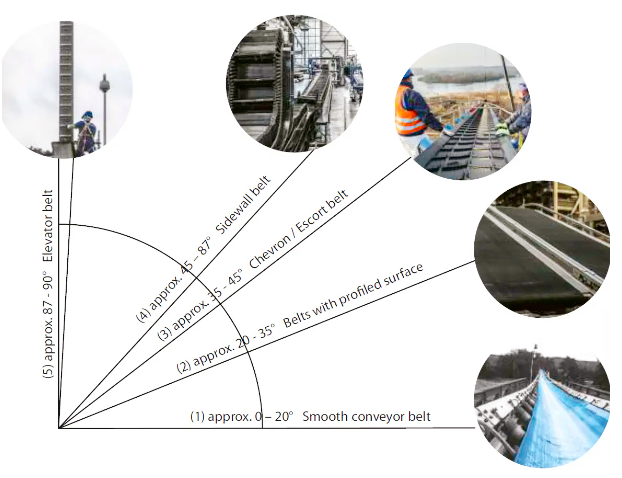
Mining, metallurgy and power industry: In these heavy industrial fields, it is used to transport bulk materials such as ore, coal, sand and gravel. Its high strength and wear resistance enable it to withstand harsh working environments such as impact, wear and corrosion.
Ports and docks: Used for loading and unloading ships, as well as transporting bulk goods such as grain, fertilizer, ore, cement clinker, etc. inside the dock. The long-distance and large-volume transportation capacity ensures the high efficiency of port operations.
Building materials industry: Rubber conveyor belts are used to transport cement, limestone, gravel, sand, clinker, etc. Its wear and heat resistance is essential for the transportation of these highly abrasive and sometimes high-temperature materials.
Chemical and grain industries: The chemical industry needs to transport a variety of powdered and granular chemicals. In the grain industry, they are used to transport grains, corn, wheat, etc., and food-grade conveyor belts are usually required to ensure hygiene.
Logistics and express delivery industry: Lightweight rubber conveyor belts are widely used in express sorting centers, airport baggage handling systems and warehouse equipment due to their good flexibility, low noise and easy cleaning.
Why do you need a rubber conveyor belt?

In the world of material handling and industrial processes, rubber conveyor belts play a vital role. These conveyors are designed to transport a variety of materials efficiently and reliably. Choosing the right rubber conveyor belt is essential to optimizing operations and ensuring a smooth workflow.
Rubber Conveyor Belt Case Studies
A rubber conveyor belt is a mechanical device that transports materials through continuous motion and is widely used for material handling in various industries. Its primary advantage lies in its ability to continuously transport a variety of bulk or pieced materials over long distances, significantly improving production efficiency and automation. The primary application of rubber conveyor belts is material conveying, which is their fundamental and core application. Whether it's lump ore and coal, powdered grain and cement, or packaged goods and luggage, rubber conveyor belts reliably transport materials from one location to another. For long-distance transportation, rubber conveyor belts can easily transport materials over long distances, even across varying terrain. This makes them a highly cost-effective solution for long-distance material handling, such as in ports, mines, and large factories. For transportation in specialized environments, rubber conveyor belts can be manufactured in various specialized configurations to suit varying work environments. For example, there are high-temperature resistant conveyor belts for transporting high-temperature materials; oil-, acid-, and alkali-resistant conveyor belts for transporting chemicals; and flame-retardant conveyor belts for applications requiring high fire protection. Specially designed conveyor belts, such as those with corrugated sidewalls, enable material transport at large angles or even vertically, significantly saving space. Tubular conveyor belts can also completely enclose materials, preventing them from scattering or becoming contaminated during transport. Overall, rubber conveyor belts, with their outstanding transport capacity and diverse functions, play an indispensable role in the material handling industry. They are key equipment for improving efficiency and reducing costs in industrial production and logistics.
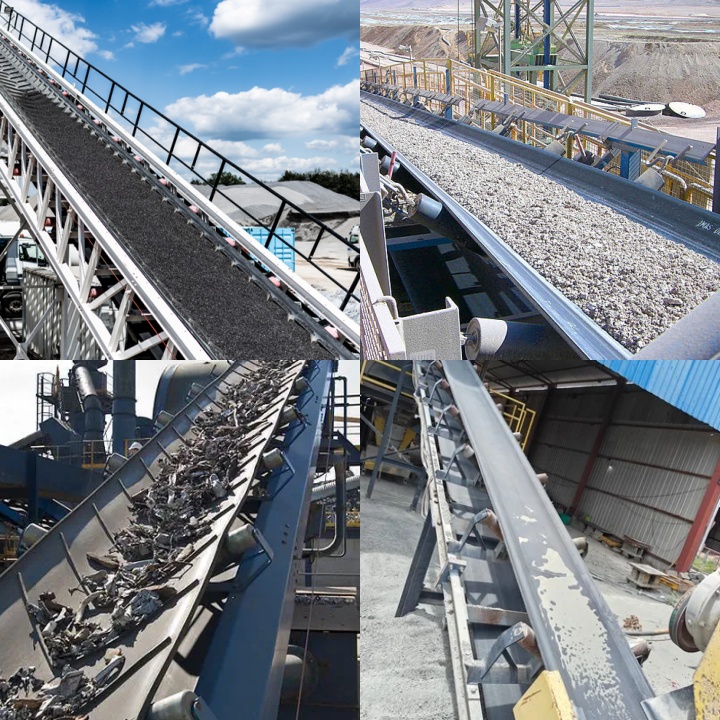
Rubber conveyor belt price
The price of rubber belt conveyors varies depending on many factors. The general or standard types have relatively simple structures and are relatively cheap. Special conveyors, such as high-angle corrugated sidewall conveyors (for vertical or large-angle conveying), tubular conveyors (enclosed conveying, dust and pollution prevention), mobile conveyors, etc., are more expensive due to their complex design and high manufacturing difficulty. In order to obtain an accurate price for rubber belt conveyors, it is necessary to provide the supplier with as detailed demand information as possible, including material name and characteristics, conveying capacity, conveying distance and lifting height, and whether there are special requirements such as whether it needs to be moved.
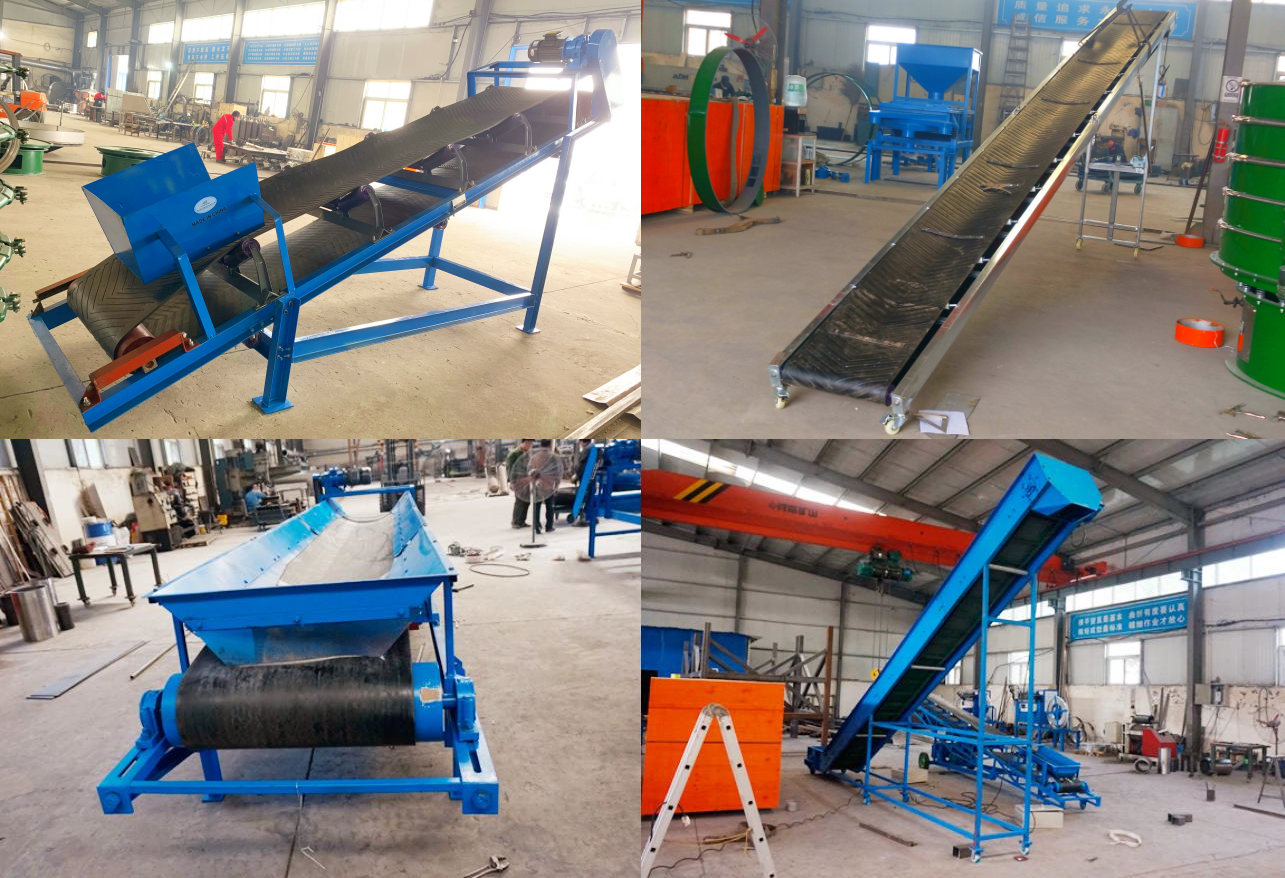
|
Model |
Belt width (mm) |
Length (m) |
Power (kw) |
Speed (m/s) |
Amount (t/h) |
Price (4/set) |
|
Horizontal sand conveyor belt |
B500 |
3 |
4-7.5 |
1.25-2.0 |
40-80 |
$2120-10750 |
|
Inclined sand conveyor belt |
B650 |
3 |
7.5-11 |
1.25-2.0 |
80-120 |
$4100-24230 |
|
Vertical sand conveyor belt |
B800 |
4 |
7.5-15 |
1.25-2.0 |
120-200 |
$5500-36300 |
|
Fixed sand conveyor belt |
B400 |
3 |
4-7.5 |
1.25-2.0 |
30-60 |
$2000-9430 |
|
Mobile sand conveyor belt |
B1000 |
5.5 |
7.5-22 |
1.25-2.0 |
200-320 |
$14800-249000 |
Supplier of Rubber conveyor belt
When selecting a supplier, there are many factors to consider, such as the type of rubber compound (e.g., natural rubber, styrene-butadiene rubber, nitrile rubber, EPDM rubber), as well as specific requirements for resistance to wear, heat, oil, and chemicals, the belt construction (fabric layers, wire cords), and any special features such as studs or sidewalls.
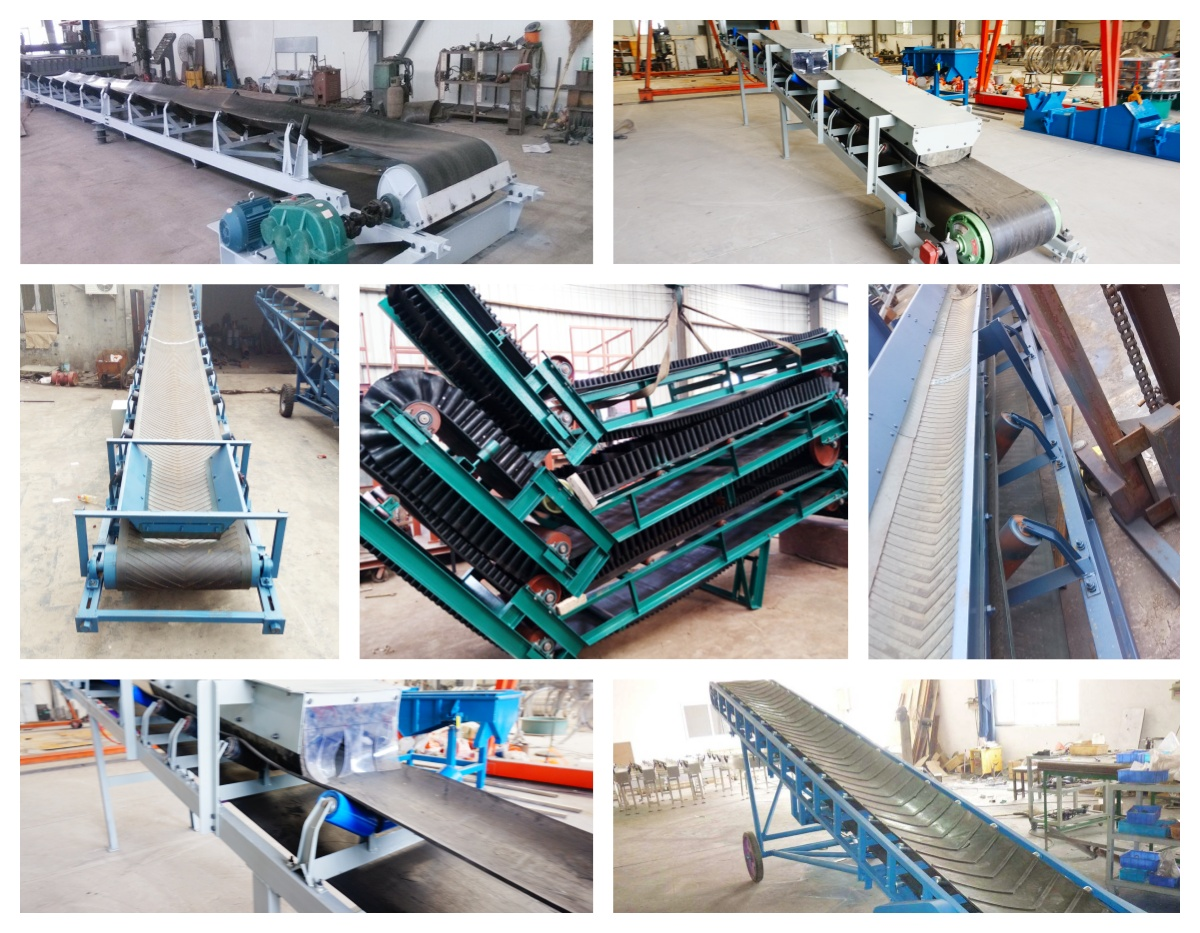
Right rubber conveyor belt is essential to optimizing operations in a variety of industries. By considering factors such as the type of transported material, the required capacity and throughput, environmental conditions, and cost, companies can choose a conveyor that meets their specific needs. By carefully evaluating different types of rubber conveyor belts and considering all relevant factors, companies can make smart investments that increase productivity, reduce costs, and improve overall operational efficiency.
